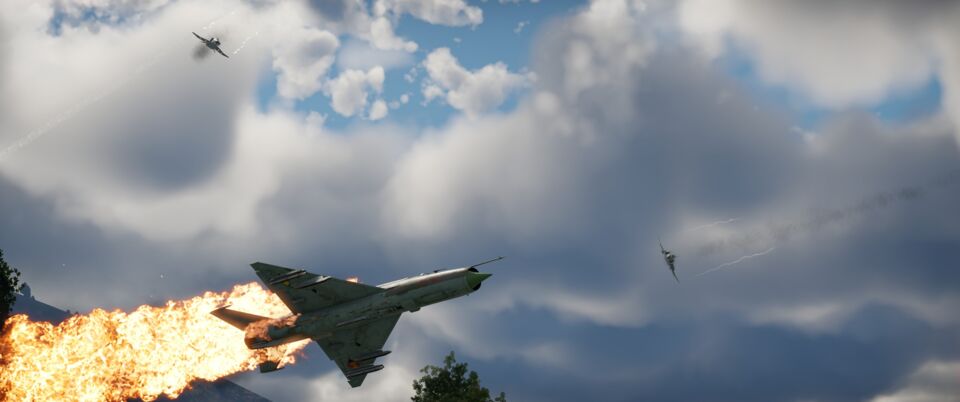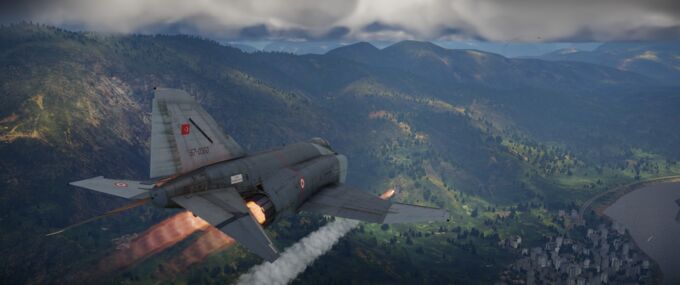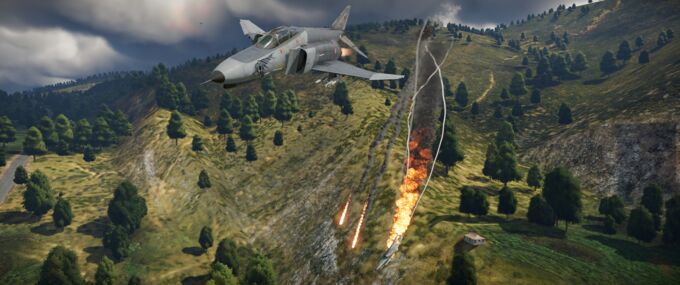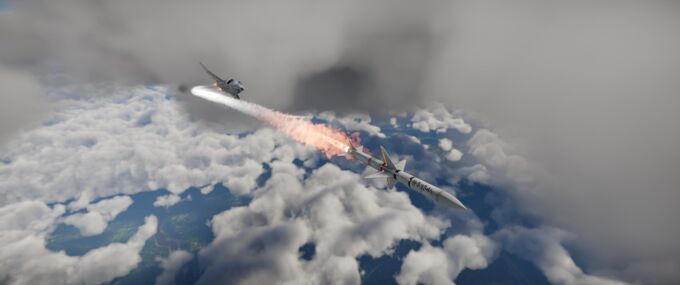The F-4E is an American 3rd generation fighter jet built to address the significant flaws found in the earlier F-4C, most notably its lack of a built-in cannon armament and countermeasures. The upgrades it received gave the F-4E a very wide appeal with export customers and made it the baseline for the vast majority of export variants to the air forces of Western-aligned nations. While many of these exports, like those to Germany and Japan, would receive downgraded avionics, a lack of radar-guided missiles, or reduced flight performance, Israel’s F-4E “Kurnass” fighters are almost identical to their American counterparts, excluding the switch to AIM-9D/G Sidewinder missiles used by the United States Navy. Regardless, American and Israeli players can benefit from the F-4E’s very user-friendly playstyle, with a very high skill ceiling that provides all the tools necessary for success when flying it.
| Pros | Cons |
| Advanced RWR and plentiful countermeasure capacity | No look-down radar mode |
| Decent engine thrust and climb rate. | Poor but not unbearable maneuverability |
| Excellent missile armament | Engines chug fuel rather quickly on afterburner |
| Vastly expanded guided ground ordnance selection | Has to sacrifice AIM-9 Sidewinder pylons to take AGM-65 Mavericks |
| Can utilize an EEGS radar-linked gunsight | No dedicated targeting pod or optics; must use the normal TV camera to lock its ordnance on target |
Air-to-Air Ordnance (Sidewinders)
The F-4 Phantom was originally designed to be an extremely fast “missile bus” that could carry up to 4 long-range AIM-7 Sparrow BVR missiles. However, doctrinal differences between the United States Navy and Air Force resulted in widely differing AIM-9 Sidewinders being used between the two branches. This difference is also reflected on the F-4E, which receives the AIM-9E and AIM-9J from the Air Force, and the Kurnass, which receives the AIM-9D and AIM-9G from the Navy.
The F-4E receives the AIM-9E stock, a short-range IR missile with a narrow uncaged seeker and 10Gs of maneuverability. These missiles are very easy to evade and have only slightly longer range than the older AIM-9B. However, the AIM-9J introduces a wider uncaged seeker and 20Gs of maneuverability, with a decent improvement in range.
The Kurnass, on the other hand, receives the naval AIM-9D Sidewinder stock. In comparison to the AIM-9E, it has much longer range and better maneuverability but is limited by a caged seeker, which restricts your ability to lead the target with the missile. The later AIM-9G fixes this issue by introducing a very wide uncaged seeker, like the AIM-9J. The Kurnass also slightly differs from the F-4E in terms of the number of Sidewinders it can carry, being able to mount two additional Sidewinders on the dedicated Sparrow bays located on the front of the fuselage for a total of six Sidewinders, providing more flexibility in your armament if you don’t want to carry the lethargic early AIM-7E Sparrow before acquiring the more nimble AIM-7E-2 Dogfight Sparrows.
Air-to-Air Ordnance (Sparrows and Cannons)
The F-4E and Kurnass receive one of the biggest quality-of-life upgrades to their radar missile armament over the older F-4C. While they still retain their four dedicated Sparrow mounts on the central fuselage, the F-4E can carry the early AIM-7E and AIM-7E-2 dogfighting Sparrows. While the AIM-7E receives considerable upgrades to its maneuverability and rocket motor over the AIM-7D, it is still heavily constrained by its excruciating guidance delay, limiting its use in close-range engagements. The AIM-7E-2 dogfighting Sparrows, however, fix this incredibly frustrating issue and can start maneuvering almost immediately off the rail, making them incredibly powerful in close-range engagements due to their 25G overload limit.
Accompanying the incredibly strong radar missile armament of the Phantom and Kurnass is the AN/APQ-120 radar. While it doesn’t have a look-down or pulse-Doppler mode, the radar has extremely long range and an EEGS radar-linked gunsight that provides ballistic calculations for the 640-round M61 Vulcan located in the F-4E’s nose. Be aware that, due to being a rotary cannon, the M61 has a tiny but noticeable spin-up time before being able to fire. Additionally, the F-4E and Kurnass can also mount up to three 1200-round GAU-4 20mm cannon pods below the fuselage for extra burst mass. However, be warned that these cannon pods drastically increase the aircraft’s weight, and the significant downward recoil from the pods can make the aircraft very troublesome to handle.
IMPORTANT: Keep in mind that while using radar missiles at sea level is difficult due to ground clutter, any target that tries to climb above you—regardless of whether you are at sea level or not—is a free target for your Sparrows. This also applies to anyone trying to defend against an F-4E chasing you. Trying to climb and gain altitude to face an F-4E head-on while they are actively chasing you is the worst position you can be in against an F-4E! The disadvantage this creates can be best illustrated by the image in sensor view below, where a normally-safe MiG-23ML staying at lower altitudes suddenly becomes extremely vulnerable to enemy radar missiles by trying to execute a half-loop upwards instead of pulling a hard turn while sticking close to the ground.
Air-to-Ground Ordnance
The F-4E receives a massive upgrade over its older F-4C counterpart by introducing several varieties of guided air-to-ground ordnance in addition to the various “dumb” munitions included as standard. This list includes TV-guided bombs such as the venerable AGM-62 Walleye glide bomb, as well as the TV-guided 2000 lb GBU-8 and AGM-65B Maverick missile. These munitions give it a limited standoff-attack capability; however, the problem with this is that the F-4 has no built-in targeting pod, forcing the player to rely on the built-in targeting optics in the weapons themselves or do so via third-person targeting.
Flight Performance
The F-4E gets two major upgrades to its flight performance over the F-4C: the workhorse J79-GE-17 engines found on the majority of export F-4 variants and the Agile Eagle leading-edge slats. However, these two changes do not alter the underlying fact that the F-4E’s maneuverability as a dogfighter is best compared to a flying brick against more agile fighters like the MiG-21, F-5, and J-7E.
The F-4E and Kurnass both receive new “Agile Eagle” leading-edge slats (displayed as combat flaps when switched on) that can be deployed regardless of airspeed, unlike regular combat flaps found on most planes at earlier battle ratings. These flaps help to forcibly limit the Phantom’s angle of attack to conserve airspeed around the transonic range of Mach 0.9–1.1 and improve energy retention when pulling harder maneuvers.
Survivability
Excluding the bulletproof glass front canopy plate, avionics are where the F-4E gets the most crucial quality-of-life and survivability upgrades over its predecessor, the F-4C, making a massive difference in terms of situational awareness and survivability. The Kurnass and F-4E alike are both equipped with the remarkably advanced AN/ALR-46 radar-warning receiver and a plentiful total of 90 countermeasures, including 60 normal-sized countermeasures and 30 large-caliber countermeasures. This addition fixes one of the most frustrating flaws of the F-4C, which is the complete lack of any countermeasures whatsoever.
The AN/ALR-46 RWR is a massive upgrade over the antiquated AN/APR-25 and AN/ALR-45 RWRs many American high-tier players are familiar with. The AN/ALR-46 is able to display if enemy radars are tracking you and/or launching SARH missiles at you and can differentiate between most Non-Pulse-Doppler (Displayed as AI) and Pulse-Doppler (Displayed as PD) radar sets. This is in addition to providing a threat database of ground-based anti-air threats like the Osa and Tor SPAA vehicles.
Significant threats
The F-4E’s BR placement prevents it from contending with many 4th generation fighters like the MiG-29 and F-16A ADF, which wield high-performance SARH missiles. However, there are several jets that the F-4E/Kurnass can encounter in its matchmaking bracket that should be paid appropriate attention to:
- F-16A Block 10: Massively outclasses the F-4E in terms of flight performance but only carries AIM-9Ls, which have no IRCCM. Do not dogfight under any circumstances. Lure them into a head-on engagement and/or force them to climb to high altitude.
- F-4J/S: These Navy Phantoms have very long-range AIM-7F Sparrows with a PDV HDN-capable radar and a helmet-mounted display for off-bore cuing missiles but have abysmal AN/ALR-45 RWRs that cannot detect if they are being tracked by radar or if a SARH missile is launched at them (unless it is from a MiG-21/23). Do not engage head-on, always go rear-aspect or opt for sneak attacks if possible.
- F/A-18A: This naval fighter jet massively outclasses the F-4E in almost every metric outside of climb rate and top speed due to its somewhat underpowered engines. Do not engage unless absolutely necessary.
- F-4EJ Kai: Receives AIM-7F Sparrows like the naval F-4J/S Phantoms but with an all-aspect PD radar, no HMD, and slightly inferior flight performance to the F-4E due to not having Agile-Eagle slats. Do not engage head-on.
- JA37C Viggen: One of the first fighters to receive an all-aspect pulse-Doppler radar set in the game, frequently seen by the F-4E. However, it only carries a maximum of two Skyflash missiles, equivalent to AIM-7E-2s.
- J-7E: Very good flight performance with a top-tier RWR but no all-aspect missiles and a very poor cannon armament. Go for sneak attacks or head-on engagements, do not dogfight under any circumstance.
Playstyle in Air Battles
The F-4E thrives at high altitudes, where it can make the best of a significant energy advantage and its powerful J79 engines to sling AIM-7E-2s, where the effects of ground clutter are minimal, while also avoiding the typical dogfighting furball that ensues at around sea level. Trying to force head-ons at high altitude with dogfighting-oriented opponents, such as the F-5 and MiG-21, or launching at opportunistic targets that suddenly climb above you and present themselves as free targets, are both very consistent methods of obtaining air-to-air kills. The F-4E can also serve as a valuable CAS aircraft for mixed battles, with a wide and varied ordnance selection and capacity.






